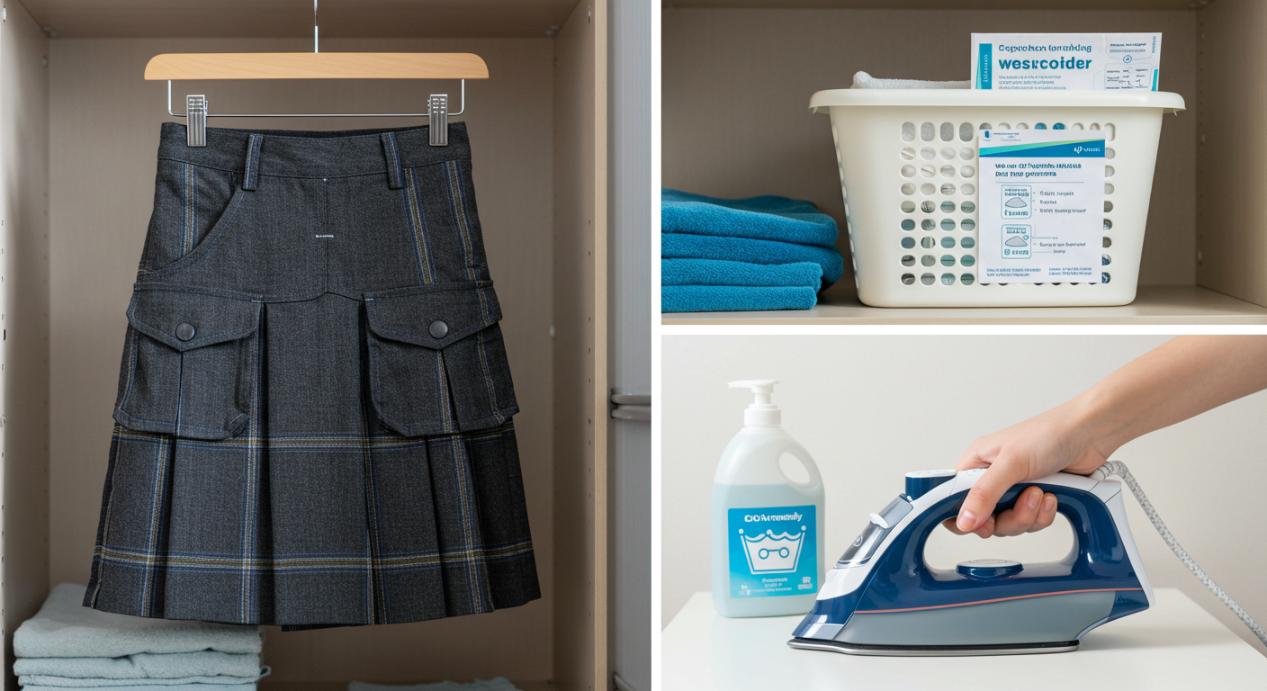Caring for Your Women’s Utility Kilt: Washing, Maintenance, and Longevity Tips

A women's utility kilt is a versatile and functional staple for outdoor adventures, festivals, workwear, or casual outings. These kilts are designed for durability and comfort. Still, like any quality garment, they require proper care to maintain their shape, fabric integrity, and overall appearance.
Whether you have a cotton, polyester, denim, or wool kilt, using the proper washing, drying, and maintenance techniques extends its lifespan and keeps it looking fresh. In this guide, we'll cover everything you need to know about washing, maintaining, and storing your womens utility kilt to ensure long-term durability.
1. Understanding the Fabric of Your Utility Kilt
Before you begin washing or maintaining your kilt, you must understand its fabric type. Different materials require different care methods to prevent shrinkage, fading, or damage.
a) Common Fabrics Used in Utility Kilts
- Cotton and cotton Blends are soft, breathable, and easy to wash, but they may shrink if not handled properly.
- Polyester and poly-cotton Blends are durable, wrinkle-resistant, and easy to clean, but they can hold odors if not washed correctly.
- Denim & Canvas: Rugged and durable but requires careful washing to prevent fading.
- Wool & Wool Blends: Provides warmth and structure but needs gentle washing to avoid shrinkage.
- Leather or Faux Leather: Stylish and strong but must be cleaned with special care to maintain texture and flexibility.
b) Checking the Manufacturer's Care Instructions
- Always read the label inside your kilt for specific fabric care recommendations before washing.
- Follow recommended temperature settings to prevent shrinking or fabric weakening.
- Use the correct detergents and stain removal methods for each fabric type.
2. Washing Your Women's Utility Kilt Properly
a) Machine Washing vs. Hand Washing
- Machine Washing:
- These utility kilt women's are suitable for cotton, polyester, and synthetic blends.
- Use a gentle cycle with cold or lukewarm water to prevent fading and fabric damage.
- Avoid washing with heavy fabrics like denim to maintain pleats and shape.
- Hand Washing:
- Recommended for delicate fabrics like wool, leather, or kilts with decorative elements.
- Use mild detergent and lukewarm water to clean the fabric gently.
- Soak for 5-10 minutes before gently scrubbing stains.
b) Choosing the Right Detergent
- Mild Detergents: Best for cotton and polyester blends to maintain fabric softness.
- Wool-Safe Detergents: Prevents shrinking or distortion in wool kilts.
- Leather Cleaners: Designed for leather kilts to clean and condition the material.
- Avoid Bleach or Harsh Chemicals: These can weaken fabric fibers and cause discoloration.
c) Removing Stains Without Damaging Fabric
- Mud or Dirt: Let it dry, then brush off before washing.
- Oil or Grease: Sprinkle baking soda or cornstarch on the stain to absorb it before washing.
- Wine or Coffee: Blot with cold water and mild detergent—avoid scrubbing aggressively.
- Ink or Dye Stains: Rubbing alcohol or vinegar may help, but always test on a hidden area first.
3. Drying Your Utility Kilt Properly
a) Air Drying vs. Machine Drying
- Air Drying:
- All fabrics should prevent shrinkage and fading.
- Hang the kilt on a wide hanger or lay flat to dry.
- Avoid direct sunlight to prevent color fading.
- Machine Drying:
- It is only recommended for cotton and polyester kilts.
- Use a low heat setting to protect the fabric structure.
- Remove promptly after drying to reduce wrinkles.
b) Preventing Wrinkles and Shrinkage
- Shake out the kilt before drying to reduce creases.
- Use a steam iron on low heat to smooth out the pleats.
- Spray with light starch to maintain pleat definition.
4. Maintaining Pleats and Shape
a) Pressing and Ironing Tips
- For Cotton & Polyester Kilts: Use medium heat with steam.
- For Wool Kilts: Place a pressing cloth over the fabric before ironing.
- For Leather Kilts: Never apply direct heat—use a warm cloth to smooth wrinkles.
b) Keeping Pleats Crisp
- Use starch spray before ironing for sharper pleats.
- Iron along pleat lines, never across, to keep definition.
- Store kilts with clips or pleat hangers to hold the structure.
5. Long-Term Storage and Preservation
a) Hanging vs. Folding Your Utility Kilt
- Hanging:
- Use wide padded hangers to keep the structure intact.
- Avoid wire hangers that can cause deep creases.
- Folding:
- Store in a breathable fabric bag in a cool, dry place.
- Prevent dust accumulation by using garment covers.
b) Protecting from Dust, Moisture, and Insects
- Store wool kilts in a garment bag to prevent moth damage.
- Use silica gel packets to absorb moisture in humid conditions.
- Keep away from direct sunlight and heat sources to avoid fading.
6. Repairing and Extending the Life of Your Utility Kilt
a) Fixing Loose or Missing Buttons, Straps, and Buckles
- Sew loose buttons using a strong thread for durability.
- Replace worn-out straps with reinforced stitching.
- Use metal buckles for long-lasting strength.
b) Repairing Tears or Worn Fabric
- Sew small rips immediately to prevent more extensive damage.
- Use matching fabric patches for durability and aesthetics.
- Iron-on patches offer a quick and easy fix for worn-out areas.
c) Restoring Leather or Wool Utility Kilts
- Apply leather conditioner to prevent cracking or drying out.
- Brush wool kilts regularly to remove dust and maintain softness.
- Use a fabric de-pilling tool for synthetic or wool-blend kilts.
7. Common Utility Kilt Care Mistakes to Avoid
- Using harsh chemicals that damage fabric.
- Skipping the care label and washing incorrectly.
- Machine drying at high temperatures causes shrinkage.
- Ignoring minor repairs leads to more significant issues.
Conclusion
Proper care of your women's utility kilt ensures it stays durable, comfortable, and stylish for years. You can keep your kilt looking fresh and functional by washing it with the proper methods, drying it carefully, and maintaining the pleats.
Whether you wear your kilt for outdoor adventures, work, festivals, or casual outings, following these maintenance tips will help preserve its quality and extend its lifespan. Start using these care techniques today, and enjoy a kilt that lasts!


